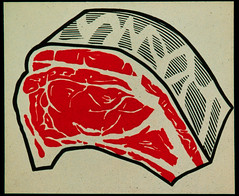There are many foods I hold as cherished comfort foods that I wouldn’t eat as a child. One of these is the Scottish dish called Mince, that my mother and grandmother used to cook, and that I would tolerate as a child but never looked forward to. Mince is Scottish comfort food, and seems unknown to most Americans, because we normally focus on the really scary Scottish dishes like haggis. (I like to joke that Scottish cuisine is based on the dare “Bet ya no can eat this.”) Scottish cooking, like a lot of traditional English and Irish cooking, is relatively bland but the dishes themselves are satisfying and filling and epitomize comfort food.
Mince is essentially a stew of ground beef, onions, and carrots in a sauce that is made from Worcestershire sauce, and that universal cooking liquid of the British Isles, water. It normally has a stew-like consistency, but in poorer households (like my Scottish grandfather’s), it was served more like a soup to help spread the food out over a large family. It’s normally served with potatoes, either boiled or mashed. I hadn’t eaten mince in years when I got a sudden craving for it and called my mother to get the basics of how she made it. My mother learned it from my grandmother, who had learned it from my great-grandmother, who had cooked at Sterling Castle (one of the royal castles of Scotland), although I doubt they ever cooked mince for the Royals. The recipe is incredibly basic, and although it’s tempting to “update” it or make it fancy, the simple version is always the one that I crave.
First, you brown some ground beef in oil in a pan. Don’t be too hasty to break the meat up. It really needs to brown and caramelize and if you turn it to frequently this won’t happen. Browning the meat creates a fond on the pan which helps build richness in the dish. After the meat is well browned, add a bunch of sliced onions. I normally use an equal volume of meat and onions, although the onions will cook down over time. Strangely, you don’t want to brown the onions as you did the meat. (This is why they are cooked in a seemingly reversed order). The onions will cook down and become translucent. My mother prefers larger pieces of onions (she cuts the onion into six wedges), but I normally will do somewhat smaller slices. Once the onions are translucent, deglaze the pan with water and Worcestershire sauce. Turn the heat down, cover the pot and let it simmer for about 30 -45 minutes or so. Then add a bunch of carrots cut into two inch lengths. I normally half the carrots top to bottom if they’re large. Cover the pot again and simmer until the carrots are tender, which can be another 20-30 minutes. I almost always serve it with mashed potatoes. You can also pass more Worcestershire sauce at the table.
It being a somewhat bland food (in that it doesn’t have a lot of spices or herbs), I prefer a somewhat mild beer with it. Not unusually, the beers from the region work very well. Scottish ales traditionally are very malty and sweet and have very few hops (because barley grows well in Scotland, but hops do not and had t be bought from Southern England). The standard 60, 70, and 80 shilling beers aren’t big and alcoholic, but are on par with most English pale ales. The rich malt of these beers makes them perfect with the browned, caramelized meat flavors of mince. Another good choice would be a Northern English style brown ale like Newcastle or Samuel Smiths. You want a beer with good malt and caramel flavors to pick up on the caramelized theme. English pale ale wouldn’t be bad either, but I would stay away from the hoppier ones if possible.
Unfortunately, I had none of these at home when I made the mince, so I ended up going with a homebrewed strong blonde beer that I have on tap that has some sweeter, almost honeyed malt notes (it’s like a junior barley wine, but not quite as hoppy). I knew the beer was a little big for the food, but of what I had, it was the best choice. It wasn’t bad, but I missed the smooth maltiness of a great Scottish ale, and think I may need to brew one in the next several weeks. It’s a subtle beer that’s a great food beer because its malt profile compliments so many dishes, particularly milder beef or lamb dishes. In any event, I was able to satisfy my mince craving.
Tuesday, July 31, 2007
Scottish Mince
Posted by
Bill
at
8:12 PM
![]()
![]()
Labels: mince, scottish ale, scottish food
Subscribe to:
Post Comments (Atom)

No comments:
Post a Comment